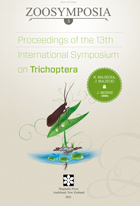Abstract
Flanders is a very densely populated region in the economic heart of Europe. To monitor the anthropological impact on the biological integrity of the freshwater courses, the Flemish Environment Agency (VMM) uses the Multimetric Macroinvertebrate Index for Flanders (Gabriels et al. 2006) which was recently developed under the influence of the European Water Framework Directive (WFD, EU 2000). This multimetric tool replaces the Belgian Biotic Index (BBI: range 0=dramatically poor quality to 10=very good quality), a monitoring system based on the sensitivities to pollution of the different macroinvertebrate taxa (De Pauw & Vanhooren 1983, De Pauw et al. 1986). Although recently replaced, the BBI has been used for the past 20 years and this extensive monitoring campaign produced a considerable amount of information on the distribution of macroinvertebrate taxa in Flemish freshwater courses. The Trichoptera (caddisflies) constitute one of these taxa. Unfortunately, determinations of caddisflies as part of the BBI monitoring, are accomplished only at the family level. Specific information on the occurrence and ecological preferences at the species level is scarce and outdated. The only comprehensive report documenting the occurrence of Trichoptera in Belgium dates back to 1984 (Stroot 1984) and since then only minor revisions and additions to the original report have been published (Stroot 1985, 1987; Stroot & Neven 1989). Therefore, the objectives of our research are to update the old species records and to elaborate and improve the ecological and phylogenetic knowledge of the Flemish Trichoptera by (a) identifying the caddisfly species that occur in Flanders; (b) determining their present distribution; (c) detecting which environmental variables influence this distribution; (d) studying whether the relationship among these variables and the species assemblages can be used to distinguish among the ecoregions in Flanders, which are based on similarities in climate, geology, geomorphology, (geo)hydrology and soil characteristics (Sevenant et al. 2002) and (e) investigating the phylogenetic relationships among the Flemish Trichoptera and evaluating their accordance with the current taxonomic classification.

